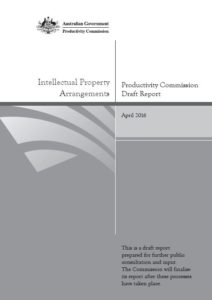Something Old, Something New Amongst the Commission’s Many Draft Recommendations
By Peter Caporn, Principal
 The Australian Government’s Productivity Commission released its draft report on ‘Intellectual Property Arrangements’ on 29 April 2016 and the draft recommendations are likely to cause a stir. The draft report can be accessed in full here.
The Australian Government’s Productivity Commission released its draft report on ‘Intellectual Property Arrangements’ on 29 April 2016 and the draft recommendations are likely to cause a stir. The draft report can be accessed in full here.
The draft report makes for a very interesting read. It is almost certain that there will be a flurry of submissions in response to the report, due by 3 June 2016. Any proposed submissions may be made here.
The points below are just some that occur immediately as important. There will no doubt by many others as we get an opportunity to review the draft report in detail. Most will be aware that we have had many IP related reports recently in Australia. However, as this draft report points out, most of these have been directed at only one or two components of the whole IP landscape. This draft report seeks to provide a more all encompassing approach, and one with a social conscience.
Quality of Patents Needs to be Improved
A specific issue that will no doubt again attract attention is the now familiar conclusion of such reviews, that the quality of Australian patents needs to be improved. This is proposed by the following means:
“increase the degree of invention required to receive a patent, abolish the innovation patent, redesign extensions of term for pharmaceutical patents, limit business method and software patents, and use patent fees more effectively.”
Australia’s patent system is said to “grant protection too easily”, resulting in a “proliferation of low-quality patents” that in turn frustrates both the efforts of follow on innovators and competition, and ultimately results in increased cost to the community. A key part of what is proposed is a further “raising of the bar” in terms of inventive step, beyond those changes introduced with the still recent amendments to the Patents Act that largely took effect in 2013. Exactly how this will be achieved is not detailed.
Innovation Patents
As noted above, one of the Commission’s draft recommendations is that the innovation patent system be abolished. This was widely expected. The Commission suggests that innovation patents are awarded for ‘obvious inventions’ thereby undermining confidence in the patent system and discouraging investment. A better outcome may be a modification of the existing innovation patent system and many options to do so were outlined during the recent review of the innovation patent system.
Business Methods and Software (BM&S)
The Commission suggests that their newly characterised technology subset ‘BM&S’ should be specifically excluded from patent protection. Patents on this technology is said to be ‘unnecessary’, a conclusion bound to inspire a robust response. The Commission has adopted a narrow view of how ip relating to business methods and software is used and the impact it has. It will be particularly interesting to see if the reasoning set out as support for this draft recommendation survives the submissions that it will no doubt attract in response.
Australia Paying the Cost for Overseas IP Owners
One useful observation in my view is the fact that as a net importer of IP, Australia is bearing the burden of the allegedly ‘excessive IP rights’, with the profits flowing off-shore and the costs impacting Australian consumers and taxpayers. However, the very difficult question that results is exactly where to draw the line? Taken to an extreme, one response is to simply withdraw from participation in the global economy – a clearly impractical solution.
Copyright Duration
The duration of copyright protection in Australia is also singled out as particularly problematic, with the Commission observing that most works are protected for ‘decades longer’ than necessary and that costs for the community subsequently are far greater than they need be.
Improving the Trade Mark System
A return to the practice of employing disclaimers is proposed amongst a range of recommendations, also including greater fees for multiple class applications and those that claim entire classes of goods or services. Also, it is recommended that the online search services of the Trade Marks Office and the Australian Securities and Investments Commission (ASIC) be linked so as to provide a warning of potential trade mark infringement to those seeking to register business and company names.
IP Right Enforcement
Australia’s enforcement mechanisms are noted to work well for ‘large rights holders’, reforms are necessary to improve the lot of ‘small and medium-sized enterprises’. Some of the changes have already commenced, including Federal Court reforms focusing on lower costs and more informal alternatives. The Federal Circuit Court is identified as one option for improvement.
IP Policy Development and Implementation
Australia lacks a ‘coherent and integrated approach’ to IP policy. Increased stakeholder consultation is identified as necessary.
Speak Now or Forever Hold Your Peace
Whether the socially responsible IP regime that the Report proposes is achievable in the context of Australia’s international obligations under various treaties and agreements, whether they be specific IP treaties or any of the many general bi-lateral or regional trade agreements, will be a key question. The Commission has also set out a series of ‘Information Requests’ seeking responses on a broad range of issues, from patent claim construction to the possible separation of IP policy and administration. For the moment it is contingent on all users of IP to take an interest in the Report and respond accordingly.
